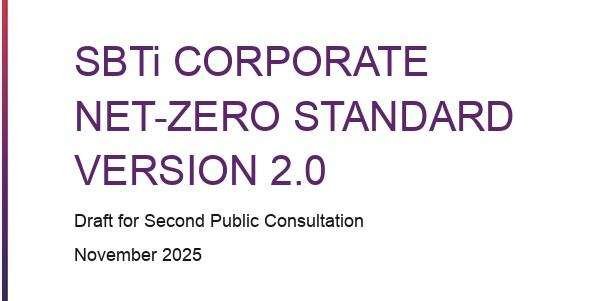
The Science Based Targets initiative (SBTi) announced the release of its updated draft Corporate Net-Zero Standard V2, its planned update to its key standard to assess, certify and track companies’ decarbonization commitments to achieve net zero emissions and to support science-based climate target setting.
According to the SBTi, the new draft aims to enable more companies to set net zero goals by “making science-based climate action more accessible and actionable,” while simultaneously balancing the need to maintain alignment with global climate goals. Among the key changes introduced in the new draft is a “a menu of options for companies to drive down their carbon footprint,” according to SBTi CEO David Kennedy, including multiple pathways allowed for target setting for direct emissions reductions, and clearer rules for the use of instruments such as carbon credits to reach decarbonization goals.
The SBTi was founded in 2015 with the goal to establish science-based environmental target setting as a standard corporate practice. The organizations’ key functions include defining and promoting best practice in emissions reductions and net-zero targets in line with climate science, providing technical assistance to companies who set science-based targets, and providing companies with independent assessment and validation of their emissions reduction targets. To date, nearly 12,000 companies have set science-based emissions reduction targets with the SBTi, or made commitments to do so.
The organization’s flagship first Corporate Net-Zero Standard was published in 2021, and the SBTi announced plans early last year to update the standard.
In March 2025, the SBTi released its initial draft of the new V2 standard, and launched a consultation into a series of the changes introduced, including proposals to add allow multiple methods for reaching emissions targets, require explicit Scope 2 (purchased energy) emissions targets, require large companies to set Scope 3 value chain emissions goals. The initial draft also included a consultation on options to address residual emissions on the pathway to net zero, including the introduction of interim carbon removal targets, as well as formally recognizing companies which are investing in Beyond Value Chain Mitigation (BVCM).
Following feedback from the first draft’s public consultation and expert working groups, the SBTi’s new draft further develops and refines the proposals, including an update to the key ambition for companies, changing from “Companies shall publicly commit to reaching net-zero greenhouse gas emissions by no later than 2050,” to “Companies shall set an ambition to transition their operations and value chains to align with the goal to be net-zero by no later than 2050,” with the SBTi noting that the new language avoids confusion from the word “commitment,” focusing instead on “the company’s overarching intention to reach net-zero by 2050.”
For direct operations Scope 1 emissions, the new draft introduces 3 approaches for target setting – including reducing emissions on a linear pathway to net-zero, increasing the share of low-carbon activities over time, and implementing Asset Decarbonization Plans to decarbonize assets based on technological readiness. The draft also adds some flexibility and clarity to Scope 2 target setting requirements, including maintaining requirements for all companies to set near-term targets, but making long-term targets optional for smaller companies, specifying criteria for near-term targets, adding mechanisms for limited amounts of electricity, heat, steam and cooling to be excluded from the near-term targets, and improved criteria for purchasing low carbon electricity.
The proposed updated standard’s Scope 3 approach focuses on addressing priority emissions sources that can have the greatest impact, while allowing flexibility, with the SBTi noting that value chain emissions have formed one of the most significant barriers to companies’ setting of science-based targets. The new draft increases focus from the initial draft on targeting the highest-priority emissions in the near-term while exclusions for lower-impact activities and areas where influence is limited, while also introducing three options for Scope 3 target setting – including “emissions intensity,” “activity alignment,” and “counterparty alignment” – noting that the options “reflect the diversity of value chain emissions and the different mitigation strategies companies use across their value chains.”
One of the key changes in the new draft is the formalization of the integration of the use of environmental attribute certificates (EACs), such as carbon credits or energy and commodity certificates, while including strict conditions. For example, Scope 2 targets can include matching using low-carbon electricity EACs that are purchased in the same region as the company’s electricity consumption, while Scope 3 targets may use EACs on a limited basis where direct supplier engagement or physical traceability is not feasible.
The SBTi’s new draft standard also adds a new recognition mechanism aimed at incentivizing companies by highlighting early, voluntary action to address ongoing emissions, introducing a “leadership” category, which includes large companies addressing 100% of their ongoing scope 1-3 emissions, or smaller companies addressing 100% of Scope 1 and 2 emissions.
Additionally, the new draft also includes new requirements for large companies (or Category A companies, which include large companies in all countries and medium-sized companies in high-income countries), including a requirement for the publication of credible transition plans within 12 months of target validation, as well as to address an increasing portion of ongoing emissions, or those not yet reduced on the pathway towards net zero by 2050, from 2035 through a portfolio of carbon removals.
David Kennedy, Chief Executive Officer at the Science Based Targets initiative, said:
“Businesses are driving global decarbonization, and will be key to achieving our climate objectives. Taking science-based action both reduces emissions and manages transition risks, maintaining competitiveness and offering growth opportunities in a carbon-constrained world.”
The SBTi’s consultation on the new draft will run through December 8, 2025, with plans for the Standard to be published for use in 2026. Click here to access the draft and consultation.














